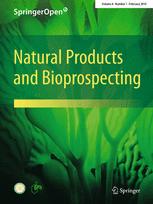|
|
The Lifespan-Promoting Effect of Otophylloside B in Caenorhabditis elegans
Collect
Jie Yang, Qin-Li Wan, Quan-Zhang Mu, Chun-Feng Wu, Ai-Jun Ding, Zhong-Lin Yang, Ming-Hua Qiu, Huai-Rong Luo
Natural Products and Bioprospecting. 2015, 5 (4): 177-183.
DOI: 10.1007/s13659-015-0064-4
Aging is the major risk factor for many human diseases and degeneration. Thus, clinically effective medicine could delay the process of aging and aging-related diseases are desperately wanted. In traditional Chinese medicine(TCM), some were claimed to slow down aging. Qingyangshen(Cynanchum otophyllum schneid) is such a TCM. Here, we assayed the longevity effect of compound Otophylloside B(Ot B), a C-21 steroidal glycoside isolated from Qingyangshen, in Caenorhabditis elegans, which is a popular model for aging research. Our results showed that Ot B could modestly extend the lifespan of C. elegans, delay the age-related decline of body movement and improve the stress resistance. Further investigating the molecular mechanism of lifespan extension effect revealed that Ot B could activate the FOXO transcription factor DAF-16. Ot B could not further extend the lifespan of long-lived mutant of insulin/IGF-1-like receptor(daf-2). In addition, Ot B also requires SIR-2.1 and CLK-1 which is an enzyme in ubiquinone synthesis, for lifespan extension.
References |
Related Articles |
Metrics
|
|
|
Monoterpenoid Indole Alkaloids from Inadequately Dried Leaves of Alstonia scholaris
Collect
Xu-Jie Qin, Yun-Li Zhao, Chang-Wei Song, Bei Wang, Ying-Ying Chen, Lu Liu, Qiong Li, Dan Li, Ya-Ping Liu, Xiao-Dong Luo
Natural Products and Bioprospecting. 2015, 5 (4): 185-193.
DOI: 10.1007/s13659-015-0066-2
Six new indole alkaloids, named alstoniascholarines L-Q(1-6), together with nineteen known analogues were isolated from the inadequately dried leaves of Alstonia scholaris. Their structures were elucidated on the basis of extensive analysis of spectroscopic data and by comparison of their physical and spectroscopic data with the literature values. In addition, the new alkaloids were tested for their cytotoxic and neurite outgrowth-promoting activities.
References |
Related Articles |
Metrics
|
|
|
Fusagerins A-F, New Alkaloids from the Fungus Fusarium sp.
Collect
Hao Wen, Yan Li, Xingzhong Liu, Wencai Ye, Xinsheng Yao, Yongsheng Che
Natural Products and Bioprospecting. 2015, 5 (4): 195-203.
DOI: 10.1007/s13659-015-0067-1
Fusagerins A-F(1-6), six new alkaloids including a unique one with the rare a-(N-formyl) carboxamide moiety(1), a hydantoin(imidazolidin-2, 4-dione) derivative(2), and four fungerin analogues(3-6), were isolated from the crude extract of the fungus Fusarium sp. , together with the known compound fungerin(7). Compound 2 was isolated as a racemate and further separated into two enantiomers on a chiral HPLC column. The structures of 1-6 were determined mainly by NMR experiments, and the absolute configuration of 1 and 2 was assigned by electronic circular dichroism(ECD) calculations. Compound 7 showed antibacterial activity against Staphylococcus aureus and Streptococcus pneumoniae, and weak cytotoxicity against the T24 cells.
References |
Related Articles |
Metrics
|
|
|
A Novel Trypsin Inhibitor-Like Cysteine-Rich Peptide from the Frog Lepidobatrachus laevis Containing Proteinase Inhibiting Activity
Collect
Yu-Wei Wang, Ji-Min Tan, Can-Wei Du, Ning Luan, Xiu-Wen Yan, Ren Lai, Qiu-Min Lu
Natural Products and Bioprospecting. 2015, 5 (4): 209-214.
DOI: 10.1007/s13659-015-0069-z
Various bio-active substances in amphibian skins play important roles in survival of the amphibians. Many protease inhibitor peptides have been identified from amphibian skins, which are supposed to negatively modulate the activity of proteases to avoid premature degradation or release of skin peptides, or to inhibit extracellular proteases produced by invading bacteria. However, there is no information on the proteinase inhibitors from the frog Lepidobatrachus laevis which is unique in South America. In this work, a cDNA encoding a novel trypsin inhibitor-like(TIL) cysteine-rich peptide was identified from the skin cDNA library of L. laevis. The 240-bp coding region encodes an 80-amino acid residue precursor protein containing 10 half-cysteines. By sequence comparison and signal peptide prediction, the precursor was predicted to release a 55-amino acid mature peptide with amino acid sequence, IRCPKDKIYKFCGSPCPPSCKDLTPNCIAVCKKGCFCRDGTVDNNHGKCVKKENC. The mature peptide was named LL-TIL. LL-TIL shares significant domain similarity with the peptides from the TIL supper family. Antimicrobial and trypsin-inhibitory abilities of recombinant LL-TIL were tested. Recombinant LL-TIL showed no antimicrobial activity, while it had trypsin-inhibiting activity with a Ki of 16.5178 μM. These results suggested there was TIL peptide with proteinase-inhibiting activity in the skin of frog L. laevis. To the best of our knowledge, this is the first report of TIL peptide from frog skin.
References |
Related Articles |
Metrics
|
|
|
Anti-sickling Activity of Ursolic Acid Isolated from the Leaves of Ocimum gratissimum L.(Lamiaceae)
Collect
Dorothée Dinangayi Tshilanda, Damase NguwoVele Onyamboko, Philippe Babady-Bila, Koto-te-Nyiwa Ngbolua, Damien ShaTshibey Tshibangu, Eddy dia Fita Dibwe, Pius Tshimankinda Mpiana
Natural Products and Bioprospecting. 2015, 5 (4): 215-221.
DOI: 10.1007/s13659-015-0070-6
The present study reports in vitro anti-sickling activity and phytochemical analyses of the leaves of Ocimum gratissimum. Biological testing revealed that the plant extracts possess antisickling effects. The combination of spectroscopic techniques:1D-NMR, 2D-NMR and MS revealed that ursolic acid is the major biologically active compound of O. gratissimum(Silva et al. in Molecules 13:2482-2487, 2008;Kedar et al. J Food Drug Anal 20:865-871, 2012). This study is the first report of the antisickling activity of ursolic acid isolated from O. gratissimum. The pharmaceutical relevance of findings from this study derives from the possibility of integrating O. gratissimum as an antisickling plant in the pharmacopoeia of Democratic Republic of the Congo. The identification of the active principle could enhance the standardization of antisickling recipe.
References |
Related Articles |
Metrics
|
|

